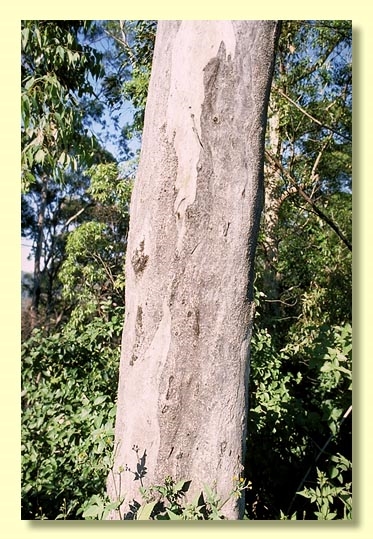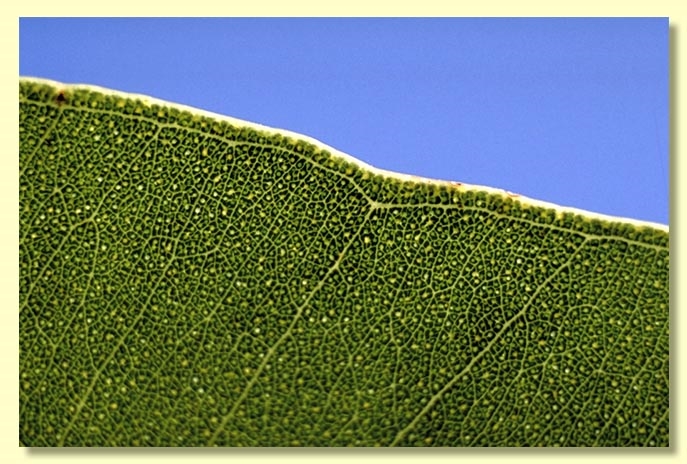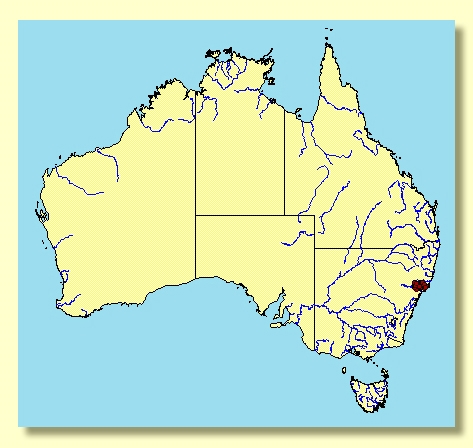Euclid - Online edition
Eucalyptus canaliculata
Eucalyptus | Symphyomyrtus | Latoangulatae | Lepidotae-Fimbriatae
Eucalyptus canaliculata Maiden, J. Roy. Soc. New South Wales 54: 171 (1920).
Based on E. punctata var. grandiflora H.Deane & Maiden, Proc. Linn. Soc. New South Wales 26: 133 (1901). T: 7 miles [c. 11 km] from Dungog on the Booral Road, NSW, Sept. 1920, A.Rudder s.n.; lecto: NSW, fide J.H.Maiden, Crit. Revis. Eucalyptus 3: 195 (1917).
E. punctata var. major R.T.Baker & H.G.Sm., A Research on the Eucalyptus especially in regard to their Essential Oils (1902) 128. T: "occurs only at Booral, New South Wales (A.Rudder)".
Bark smooth, becoming granular with age, predominantly grey or cream with brown, pink or orange patches.
Juvenile growth (coppice or field seedlings to 50 cm): stem rounded or square in cross-section; juvenile leaves always petiolate, opposite for about 5 pairs then alternate, lanceolate to ovate, 6–18 cm long, 2–5 cm wide, base tapering to petiole, discolorous, dark green above.
Adult leaves alternate, petiole 1.5–3 cm long; blade lanceolate to falcate, 8–17 cm long, 1.5–5 cm wide, rarely undulate, base usually tapering to petiole or rounded, discolorous, glossy, darker green above, paler below, strongly penniveined, dense to very densely reticulate, intramarginal vein parallel to and just within margin, oil glands, numerous island and intersectional.
Inflorescence sometimes terminal compound, more commonly axillary unbranched, peduncle broadly flattened, 1.3–2 cm long, buds 7 per umbel, pedicels 0.5–0.8 cm long. Mature buds ovoid to diamond-shaped (0.8–1.1 cm long, 0.6–0.7 cm wide), with 2 longitudinal ribs extending from pedicel to hypanthium, outer operculum warty or wrinkled shedding close to bud maturity, inner operculum smooth and narrower than hypanthium, consequently scar present only late in bud development, operculum conical to rounded, stamens inflexed, anthers cuboid or cuneate, versatile, slits separate, style long, stigma tapered, locules 3 or 4, the placentae each with 4 vertical ovule rows. Flowers white.
Fruit pedicellate (pedicels 0.2–0.8 cm long), obconical or hemispherical, 0.6–1 cm long, 1–1.5 cm wide, sometimes with 2 longitudinal ribs, disc raised-convex, valves 3 or 4, strongly exserted.
Seeds black, 1–3 mm long, pyramidal to cuboid, dorsal surface pitted, hilum terminal.
Cultivated seedlings (measured at ca node 10): cotyledons bilobed; stems square in cross-section; leaves always petiolate, opposite for ca 4 to 5 nodes then alternate, lanceolate, 6–10 cm long, 2–3.7 cm wide, base tapering, discolorous, darker green above.
Flowering has been recorded in February.
A small to medium-sized tree belonging to the grey gums, occurring in the Dungog–Gloucester area, usually on poor sites such as dry ridge tops. Characterised by its smooth-granular grey gum type bark, discolorous leaves that are paler on the underside, and relatively large buds and fruit.
Eucalyptus canaliculata belongs in Eucalyptus subgenus Symphyomyrtus section Latoangulatae because cotyledons are bilobed, leaves are discolorous and have side-veins at a wide angle to the midrib, buds have two opercula and fruit have exserted valves. Within this section, it is one of six species forming series Lepidotae-Fimbriatae (the grey gums) with ovules in 4(6) rows and the bark smooth throughout becoming granular with age. The series Lepidotae-Fimbriatae can be informally divided further into two groups based on seed colour and the presence or absence of small teeth on the seed edge. E. punctata, E. canaliculata, E. longirostrata and E. grisea all have black seed that are prominently toothed along the edges. E. propinqua and E. major have brown to light brown seed that have a much smoother surface texture than the other group, lacking the prominent teeth on the seed edge. Also the bark of E. propinqua and E. major tends to shed in strips rather than patches like the other grey gums.
E. canaliculata differs from other grey gums by having the largest buds and fruits of the group, with the fruit usually > 1 cm in width and up to 1.5 cm. All the other grey gums have fruit normally narrower than 1 cm wide.













